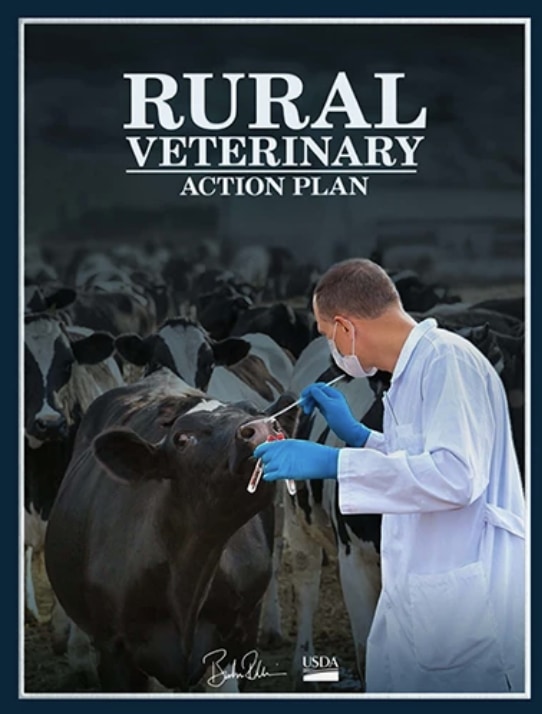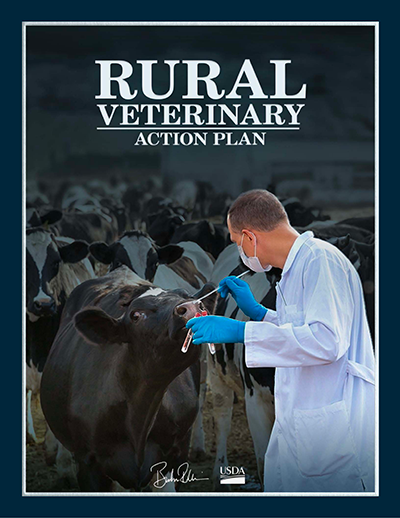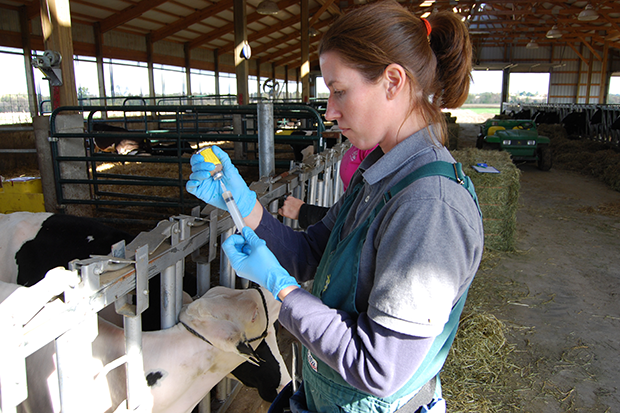USDA announces plan to address rural, federal veterinary shortages

USDA announces plan to address rural, federal veterinary shortages
By Malinda Larkin
More funding, listening sessions, and better anticipating shortage areas are part of Rural Veterinary Action Plan
Rural areas are struggling more than ever to find and keep veterinarians. The U.S. Department of Agriculture (USDA) has determined nearly every U.S. state has at least one rural or livestock-producing region lacking adequate veterinary services.
In addition, the USDA’s Animal and Plant Health Inspect Service (APHIS) and Food Safety and Inspection Service (FSIS) rely on veterinarians to protect livestock and poultry from diseases such as highly pathogenic avian influenza and the New World screwworm and protect public health by ensuring the wholesomeness of meat and poultry.
In the interest of maintaining animal and public health, food safety and the agricultural economy, and the ability to prevent and combat these diseases, the USDA is launching the Rural Veterinary Action Plan (RVAP), an initiative to increase the number of rural food animal veterinarians across the U.S. and recruit new veterinarians to join the agency, according to an August 28 announcement.

"The AVMA applauds the USDA for recognizing and working to address the immediate need to recruit and retain veterinarians in rural and underserved communities," Dr. Michael Bailey, AVMA president, said in a statement. "Strengthening the nation’s animal health infrastructure and agricultural economy relies on the expertise of livestock and public health veterinarians. Through the Rural Veterinary Action Plan, animal and human welfare will be maintained, our food supply will be protected, and public health will be safeguarded. We look forward to working with the USDA on implementation of the Rural Veterinary Action Plan."
Grant funding
Data from the American Association of Veterinary Medical Colleges estimates that only 20% of first-year students come from rural backgrounds with a similar percentage expressing interest in rural practice. Further, the AVMA estimates that in 2024, just 3.4% (3,424) of the total U.S. veterinary workforce (130,415) were employed in a food animal practice, 5.9% into equine practice, and 9.6% into mixed animal practice.
In addition, hundreds of veterinarians work for FSIS and APHIS, but for more than a decade, the agencies have struggled to fill and maintain many of those positions, especially rural posts, port inspections, and export certification roles. The issue largely has to do with government pay being less competitive compared with private practices in urban and suburban areas, according to the USDA announcement.
To help address these issues, the USDA outlined five actions in the recently announced Rural Veterinary Action Plan:
- Enhance and streamline veterinary grant programs
- Analyze rural veterinary shortages to better understand the need
- Recruit and retain USDA veterinarians
- Catalog federal resources available to veterinarians for starting a practice
- Work with stakeholders, including veterinary schools, to understand the barriers to entry and increase recruitment from rural areas
As part of the announcement, U.S. Secretary of Agriculture Brooke L. Rollins named two awardees of the USDA’s National Institute of Food and Agriculture’s (NIFA) Veterinary Services Grant Program (VSGP) for this year that will help expand veterinary practices in rural areas of Mississippi:
- $125,000 to Dr. Kimberely Klunk, who will serve Mississippi veterinary shortages in Adams, Franklin, and Lincoln counties. The grant will support a community-needs assessment as well as buying new tools to provide advanced livestock reproductive services and new transportation for farm calls.
- $125,000 to Dr. Rachel W. McCurdy, who will serve Mississippi veterinary shortages in Newton and Scott counties. The grant will provide for updated diagnostic tools and equipment, enhanced transportation, and educational outreach to producers and farmers.
In the past, VSGP grants have been awarded to universities and veterinary practices working to address shortages of food animal veterinary services across the nation. In 2024, 25 grants totaling $3.8 million were issued.
This year, however, the program will not issue a request for applications in FY25. Next fiscal year, NIFA will issue a request for applications “upon receipt of appropriations."
In addition, NIFA runs the Veterinary Medicine Loan Repayment Program (VMLRP), which offers educational loan repayment to veterinarians in exchange for working in one of these shortage areas for up to three years.
Typically, applications for the VMRLP and the VSGP open in early March, but because of a temporary freeze on federal grants pending their review, they had been paused.
Now the USDA says it will make up to an additional $15 million available in funding for additional qualified applicants to serve in rural areas; however, details of the funding implementation have yet to be laid out by the USDA. The request for applications for the VMLRP will open in December and cover both FY2025 and FY2026 funding, and will feature a streamlined application process.

Rural shortages
In 2025, the USDA declared 243 rural veterinary shortage areas in 46 states, which is the highest number of shortage areas ever. The largest numbers of shortage areas were nominated in the Midwest and West as well as in Georgia. Beef cattle is consistently identified as having the species in greatest need.
How NIFA establishes VMLRP shortage classifications is according to type of practice and percentage of full-time–equivalent employees needed to serve the specific needs of each shortage situation area.
The issue, though, according to the action plan, is "These veterinary shortage situations are usually designated once the existing veterinarian has either moved away or retired and do not forecast where potential shortages may be in the next couple of years."
To remedy this, the USDA Economic Research Service will study this issue and produce a report by mid-2026 to be used by policymakers seeking to address this issue, including ways that veterinary shortage situations can be more forward looking.
Another project the department plans to tackle is cataloging relevant USDA programs, including rural development programs such as its Business and Industry Loan Guarantee Program, which provides loan guarantees to lenders for their loans to rural businesses, and Community Facilities Programs, in which entities can use the funds to construct, expand, or improve facilities that provide health care, education, public safety, or public services.
The aim is to better educate veterinary colleges and recent graduates about programs available to help finance clinics in rural areas, according to the announcement.
The USDA also says it will partner with universities, state and local communities, farmers, and youth groups to recruit more veterinarians for its own workforce.
Other options to bolster the number of veterinarians at the USDA including exploring "special pay rates for federal government veterinarians, increased tuition reimbursements to better align with private sector incentives, and potential implementation of a recruitment bonus for federal veterinarians."
The AVMA has long advocated for better pay for federal veterinarians. More recently, at the AVMA House of Delegates’ 2023 regular annual session, delegates approved the policy "Recruiting and Retaining Public Practice Veterinarians," which was introduced by the National Association of Federal Veterinarians.
It states, in part: "Additional studies from AVMA and other veterinary organizations support efforts for recruitment and retention benefits from increased congressional funding for all federal agencies' incentive programs such as the use of special pay (for specific hard-to-fill positions and locations), specialty pay (for board certification), professional pay (for pay equity with other medical professionals), removal of the annual salary cap in declared emergency disease outbreaks, student loan repayment bonuses, and other incentives the agency deems appropriate to encourage more veterinarians to enter and remain in public practice."
Seeking further solutions
The USDA plans to hold listening sessions until October 1 to further understand problems and solutions so leadership can determine what additional actions are needed to reverse these trends. Specific dates and times will be announced soon.
The AVMA has supported federal legislation and policies that address access gaps by providing student loan support, federal grants, and other assistance to help veterinarians serve rural and underserved communities.
To this end, the AVMA has championed the Rural Veterinary Workforce Act (H.R. 2398/S. 1163), a proposed piece of legislation that would end the federal taxation on VMLRP awards. Eliminating the tax would allow the appropriated funds to go further and enable more veterinarians to participate in a program. This would make the tax treatment of the awards the same as for the analogous program for physicians, in which awards are excluded from the recipient’s gross income.
Mississippi Sen. Cindy Hyde-Smith (R-MS) was one of the original co-sponsors of the legislation, last introduced during the 118th Congress, and co-chair of the Senate Veterinary Medicine Caucus. She was also on hand during the August 28 announcement of the Rural Veterinary Action Plan along with Rollins, Mississippi Gov. Tate Reeves, Mississippi State University President Mark Keenum, and Mississippi Farm Bureau President Mike McCormick.
"I applaud Secretary Rollins and USDA for making important changes to strengthen our veterinary workforce," Sen. Hyde-Smith said. "This announcement shows real commitment to protecting animal health and supporting our American farmers. Food security is national security, and this is exactly the kind of leadership we need."
Rollins said at the press conference that rural veterinarians are vital for the agricultural economy in the United States.
"With these new investments in scholarships and pay incentives, USDA is not only strengthening our animal food production system but also listening to producers and veterinarians across the country to ensure our programs meet real-world needs. Together, we will keep America’s food supply strong, safe, and secure," she said.
A version of this story appears in the October 2025 print issue of JAVMA
